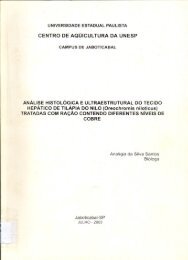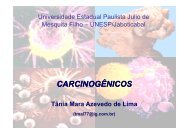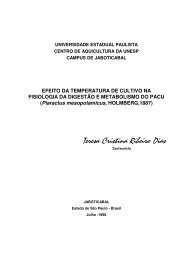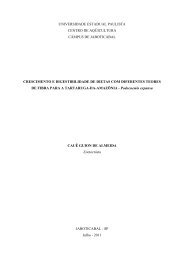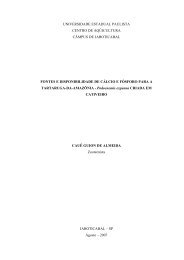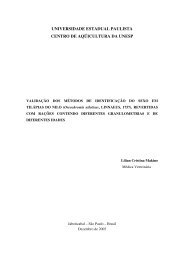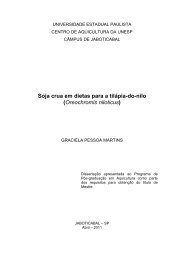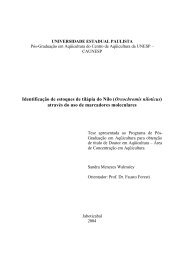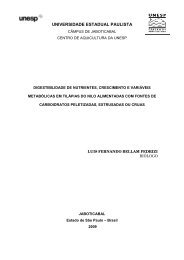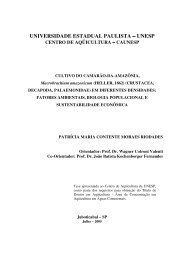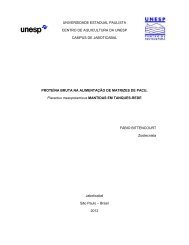Tese Michele Fagundes.pdf - Caunesp
Tese Michele Fagundes.pdf - Caunesp
Tese Michele Fagundes.pdf - Caunesp
Create successful ePaper yourself
Turn your PDF publications into a flip-book with our unique Google optimized e-Paper software.
Abstract<br />
The number of species farmed in Brazil, including the pintado (Pseudoplatystoma<br />
corruscans) has been increasing making necessary better knowledge of their physiology<br />
and farming techniques. The aim of this study was evaluate the circadian variations of<br />
blood cortisol and glucose without stresfull agents and physiological responses (blood<br />
levels of cortisol and glucose; liver and muscle glycogen; plasma chloride and<br />
osmolarity; hemathocrit, number e volume of red cells and hemoglobin) of juvenile fish<br />
submitted to different farming conditions (12h transport; alteration of photoperiod - 24<br />
h exposure to continuous light or continuous darkness; exposure to benzocaine,<br />
phenoxyethanol and clove oil). There was no statistical among cortisol levels, but<br />
numerically the day profile was different of the night profile, showing peaks of cortisol<br />
secretion at the set up of the darkness and light. Blood glucose was not correlated to<br />
cortisol profile and had the levels more constant during the night. In the transport<br />
experiment, the cortisol levels increased along the procedure followed by a gradual<br />
reduction that reached values below the control 48, 72 and 96 h after the operation.<br />
Glucose increased after transport returning to basal levels within 72h as well muscle<br />
lipid levels. Blood colesterol and protein also increased. Chloride was reduced after<br />
transport as well as hematocrit, number of red cells and hemoglobin. Metabolic data<br />
suggest the use of another energy source in place of glucose to attend the stress demand.<br />
In the experiment in which fish were submitted to 24 h of light or darkness, blood<br />
cortisol did not differ statistically, but the values found in fish under 24 h of light were<br />
numerically higher compared to those of fish under darkness and both compared to<br />
control fish. Glicemia was numerically reduced in fish under darkness. No<br />
osmorregulatory disturbance was seen. Hematocrit, number of red cells and hemoglobin<br />
had the same profile increasing after 24 and 72 h of exposure of either light or darkness<br />
trending to be higher in fish exposed to light. Lately, fish were exposed to anesthetic<br />
(25, 50 and 75 mg/L benzocaine; 0.2, 0.4 and 0.8 mL/L of phenoxyethanol and clove<br />
oil). Blood cortisol levels reduced as the eugenol concentration increased, and the same<br />
profile was observed with phenoyethanol. No difference was observed regarding<br />
benzocaine. Similarly, glucose reduced with the anesthetics increased, being the lower<br />
levels found in the lower concentrations of both anesthetics. Similar profile of reduction<br />
was seen regarding to benzocaine and eugenol in hematocrit, number of red cells and<br />
hemoglobin. In all three anesthetics, the lowest concentrations promoted the higher time<br />
13



